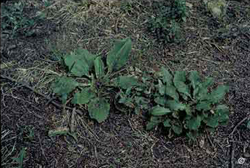Late summer and early fall is an ideal time to deal with many lawn weeds. But weed management involves more than the application of herbicides. The best defense against weeds is healthy turf.
When should I fertilize my lawn?
Turf vigor increases with regular fertilization,  and fall is the most important time of year to fertilize. Between September and early October, apply the package rate of one pound of nitrogen per 1000 square feet of turf. This encourages turf recovery after a stressful summer. Also, be sure to continue regular irrigation into the fall. This is important for two reasons. First, turf needs the water, and second, drought-stressed weeds respond poorly to herbicides.
and fall is the most important time of year to fertilize. Between September and early October, apply the package rate of one pound of nitrogen per 1000 square feet of turf. This encourages turf recovery after a stressful summer. Also, be sure to continue regular irrigation into the fall. This is important for two reasons. First, turf needs the water, and second, drought-stressed weeds respond poorly to herbicides.
Should I put herbicide on my lawn?
Before you decide to apply an herbicide, properly identify weeds. A couple of hard frosts will kill some weed species, which means herbicide treatments are not only unnecessary, they’re wasteful. These weeds include broadleaf summer annuals such as purslane, knotweed and pigweed; and grassy summer annuals like crabgrass, goose grass, barnyard grass and foxtail.
Fall herbicide sprays effectively kill such weeds as dandelion, plantain, thistle and bindweed. Use products that contain 2,4-D, MCPP, MCPA, triclopyr and clopyralid.
What is the best way to put herbicide on my lawn?
Where practical, it’s best to apply herbicides directly to affected areas only rather than broadcasting the herbicide onto the entire lawn. Always read the label on an herbicide product before purchasing, before spraying and before cleanup.
For more information, see the following Planttalk Colorado™ script(s).
For more information, see the following Colorado State University Extension fact sheet(s).



